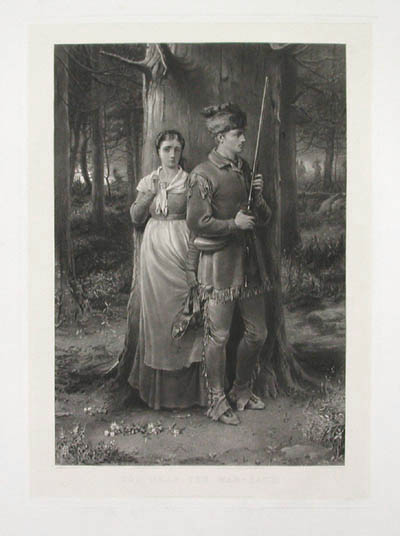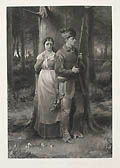| Title: |
Too Near the War-Path |
| Engraver: |
Simmons, William Henry (London, 1811 - 1882) |
| Designer: |
Boughton, George Henry (Norwich, England, 1833 - London, 1905) |
| Date: |
1875 |
| Medium: |
Original Mixed Method Engraving |
| Publisher: |
Knoedler & Company, Fifth Avenue, New York |
| Edition: |
First Edition Impression 'Proof' |
| Note: |
"Little is known of the private life of William Henry Simmons although
he was one of the finest Victorian engravers in the mixed style and produced
a vast body of work. He studied under William Finden, the line engraver,
but later abandoned line engraving for mixed mezzotint and became one of
the foremost exponents of this style." *
|
| |
The name of William Henry Simmons is found on many of the most famous
examples of large, Victorian era engravings. His first published engraving
bears the date of 1837. From that time until the year of his death (1882),
William Henry Simmons was commissioned to create engravings after the designs of such
famous contemporary artists as Sir Edward Landseer, Sir John Millais, Thomas
Faed, W. P. Frith, Holman Hunt, Richard Ansdell, Rosa Bonheur and others.
William Henry Simmons was a regular participant at the Royal Academy from 1857 to 1882. |
| |
Too Near the War-Path is a large and brilliant example
of William Henry Simmons's mixed method style of engraving. Within this impressive plate one
finds evidence of stippling, mezzotinting, etching and engraving, combining to create
superb textures and tonal values. |
| |
George Henry Boughton: One of the most popular
genre painters of the late nineteenth century, George Henry Boughton received his
artistic education in Paris. He then initially lived and worked in New York City
and was elected a full member of the National Academy of Design in 1871. Shortly thereafter,
George Henry Boughton permanently moved to London, becoming an Associate of the Royal
Academy in 1879 and an Academician in 1896. He was thus one of the few
artists of his time to receive honours from the most prestigious associations
in both America and Britain. |
| |
Although George Henry Boughton was an accomplished landscape artist his fame rested
mostly upon figure studies and genre depictions. Too Near the War-Path
portrays the dangerous existence of early American settlers and is typical
of his fine work in this area. |
| |
The Victorian Mixed Method Engraving: Perhaps the most technically demanding
form of original printmaking in the history of art, the Victorian mixed
method engraving reached its pinnacle of virtuosity in the last latter
nineteenth century. During this time large engravings were created to hang
in Victorian homes. Highly skilled engravers would often devote more than
a full year's labor to one of these large works of art, often combining
mezzotinting, aquatint, stippling, engraving and etching on the same plate.
Such is the case with this fine impression of Too Near the War-Path
created by William Henry Simmons. No other form of intensive craftsmanship could produce such an outstanding
variety of shades and tones as the mixed method engraving. |
| |
These large engravings became the driving force of the Victorian art
world. In fact, all the famous artists in England and America devoted their
energies to the lucrative engraving market. Painters of international
stature, such as George Henry Boughton (1883-1905), Sir John Everett Millais (1829-1896), Sir Edwin Landseer (1802-1873), Sir Frederic Leighton, 1st Baron Leighton (1830-1896), John George Brown (1831-1913) and Sir Lawrence Alma Tadema (1836-1912) made their fortunes more by selling engraving
rights to the publishers than by the actual sales of their paintings. This large Victorian engraving entitled, Too Near the War-Path is an original mixed method engraving |
| |
Large Victorian era engravings are now very scarce. Nineteenth
century framers had no knowledge of conservation methods and thus the majority
of these valuable works of art have simply disappeared or have been unalterably
stained and marred in their acidic matting and frames. Thankfully this beautiful example is in very good condition. |
| |
In Victorian terms this impression of "Too Near the War-Path"
is known as a 'Proof With Title'. Proofs were the first impressions
to be taken from the plate once the title was added along the lower margin
and the final edition was published. Proofs thus constitute the finest
impressions, both in their methods of printings and in the papers used.
This impression is printed on fine china paper which has been impressed
onto a larger sheet of thick, white wove paper. |
| Reference: |
* Hilary Guise, Great Victorian Engravings: A Collector's Guide, Astragal
Books, London, 1980, pp. 8 & 9. |
| Size: |
29 X 31 (Sizes in inches are approximate,
height preceding width of plate-mark or image.) |
| |
Unmatted |
| Condition: |
Printed on fine china paper which has been pressed onto a larger sheet
of white wove paper and with full margins as published by Knoedler in New
York in 1875 and bears the publisher's seal in the lower margin. Contains
minor foxing along the edges of the margins. Else, a superbly printed impression and
in excellent condition throughout. Too Near the War-Path
represents a prime, original example of the large, nineteenth century engraving. |
| Price: |
Sold - The price is no longer available. |
| Important Information: |
The artist biographies, research and or information pertaining to all the original works of art posted on our pages has been written and designed by Greg & Connie Peters exclusively for our site, (www.artoftheprint.com). Please visit us regularly to view the latest artworks offered for sale. We will soon be posting an update of our most recent research and include the biographical and historical information pertaining to our next collection of original works of art created by artists throughout the centuries. We hope you found the information you were looking for and that it has been beneficial.
Our Gallery, (Art of the Print / www.artoftheprint.com) guarantees the authenticity of every work of art we sell 100%. Full documentation and certification is provided. We offer a wide selection of international fine art dating from the early Renaissance to the contemporary art period. |








![]()
![]() or
phone Greg & Connie (905) 957-6666
or
phone Greg & Connie (905) 957-6666